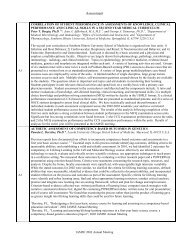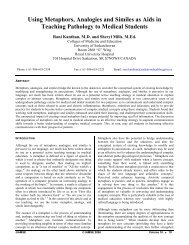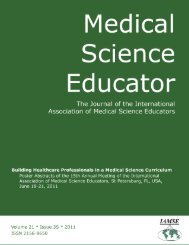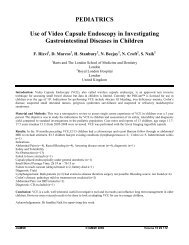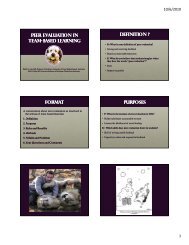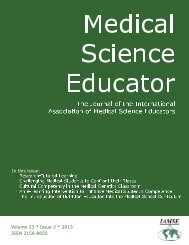Click here to view complete journal in pdf-format - IAMSE
Click here to view complete journal in pdf-format - IAMSE
Click here to view complete journal in pdf-format - IAMSE
Create successful ePaper yourself
Turn your PDF publications into a flip-book with our unique Google optimized e-Paper software.
dist<strong>in</strong>ctions between def<strong>in</strong>itions of professionalism<br />
at each level of medical education.<br />
CONCLUSIONS<br />
The study enhances understand<strong>in</strong>g of<br />
professionalism <strong>in</strong> medical education by provid<strong>in</strong>g a<br />
comprehensive framework of concrete elements <strong>to</strong><br />
def<strong>in</strong>e professionalism and how <strong>in</strong>terpretations of<br />
professionalism vary for different educational levels.<br />
This will provide a foundation for develop<strong>in</strong>g<br />
curricula that effectively educate health care<br />
professionals that uphold the professional standards<br />
of medical education.<br />
Professional Development Abstract ID: 206<br />
PEER MENTORING IN MEDICAL<br />
EDUCATION RESEARCH<br />
Judith M. Venuti, Mary Bee, Jennifer Eastwood,<br />
Melph<strong>in</strong>e Harriott, David Rodenbaugh, David<br />
Thomas, L<strong>in</strong>da Gillum and Nehad El-Sawi.<br />
Oakland University William Beaumont School of<br />
Medic<strong>in</strong>e, Rochester, MI, USA<br />
PURPOSE<br />
The Oakland University William Beaumont School<br />
of Medic<strong>in</strong>e has assembled a multidiscipl<strong>in</strong>ary<br />
faculty, whose primary role is <strong>to</strong> develop and deliver<br />
an <strong>in</strong>novative and <strong>in</strong>tegrated curriculum. Faculty<br />
must also develop scholarly work <strong>in</strong> teach<strong>in</strong>g<br />
<strong>in</strong>novations and/or medical education research. To<br />
promote faculty development and <strong>in</strong>crease<br />
productivity <strong>in</strong> these areas, we developed a<br />
“Community of Learn<strong>in</strong>g Champions”, a team of<br />
faculty that serve as peer men<strong>to</strong>rs.<br />
METHODS<br />
The team meets <strong>to</strong> discuss, advise and critique<br />
research projects developed by its members. To<br />
stimulate discussion and feedback the team uses the<br />
“step-back technique”. Briefly, <strong>in</strong>dividuals present a<br />
proposal and the rema<strong>in</strong><strong>in</strong>g members listen and ask<br />
questions. The presenter then “steps-back” and<br />
listens as the team takes on the project as if it was<br />
their own and re<strong>view</strong>s the objectives, methods and<br />
assessment <strong>to</strong>ols proposed. The presenter listens <strong>to</strong><br />
colleagues and is then <strong>in</strong>vited <strong>to</strong> reflect on the group<br />
consultation. The team has regular follow up<br />
consultation meet<strong>in</strong>gs.<br />
RESULTS<br />
Peer men<strong>to</strong>r<strong>in</strong>g had a positive impact on faculty<br />
productivity. The team provided guidance <strong>in</strong> the<br />
development of new research ideas and <strong>in</strong>creased<br />
<strong>in</strong>terest <strong>in</strong> medical education research. Future goals<br />
<strong>in</strong>clude further re<strong>view</strong> of proposals, development of<br />
a certification program, and broaden<strong>in</strong>g faculty<br />
participation. Outcome measures will be def<strong>in</strong>ed<br />
and moni<strong>to</strong>red <strong>to</strong> further determ<strong>in</strong>e the model’s<br />
effectiveness <strong>in</strong> creat<strong>in</strong>g a men<strong>to</strong>rship culture.<br />
CONCLUSIONS<br />
Peer men<strong>to</strong>r<strong>in</strong>g promoted faculty development <strong>in</strong><br />
medical education research. The team was<br />
successful <strong>in</strong> reach<strong>in</strong>g this goal as most team<br />
members now have <strong>in</strong>dividual or small group<br />
research projects. We encourage the use of this<br />
model <strong>to</strong> promote, develop and advance scholarship<br />
<strong>in</strong> medical education research.<br />
Professional Development Abstract ID: 207<br />
CAREER SUCCESS AMONG GRADUATES<br />
FROM A PRIVATE UNIVERSITY IN<br />
ECUADOR, 1999-2009<br />
Natalia Castillo, Iván Sisa, Marco Fornas<strong>in</strong>i,<br />
Universidad San Francisco de Qui<strong>to</strong>, Qui<strong>to</strong>-<br />
Ecuador<br />
PURPOSE<br />
Career success is a measure of professional<br />
competence that <strong>in</strong>volves real or perceived goals<br />
achieved by <strong>in</strong>dividuals. The aim of this study was <strong>to</strong><br />
assess career success among physicians graduated<br />
from a private medical school <strong>in</strong> Ecuador.<br />
METHODS<br />
A retrospective cohort study was conducted among<br />
eighty-four medical school graduates from 1999 <strong>to</strong><br />
2009. They were asked by email <strong>to</strong> <strong>complete</strong> an onl<strong>in</strong>e<br />
Career Success Scale (CSS) developed by<br />
Buddeberg-Fischer, et al., <strong>in</strong>volv<strong>in</strong>g 7 items on a<br />
scale from 0 <strong>to</strong> 11. Higher scores reflect better<br />
performance. It was validated <strong>in</strong> 406 Swiss medical<br />
graduates with a mean age of 33.2 (achieved score<br />
1.8+2.3).<br />
RESULTS<br />
Overall response was 73.8% and 54.8% were female.<br />
The mean score of success was 3.4+2.4.<br />
Demographic fac<strong>to</strong>rs (gender, age and marital<br />
status), family and academic background were not<br />
statistically significant fac<strong>to</strong>rs. Men were<br />
significantly more likely than females <strong>to</strong> strive for<br />
an academic or a hospital career as compared <strong>to</strong><br />
private practice, research or public health (p< 0.05).<br />
Among academic fac<strong>to</strong>rs, the only significant fac<strong>to</strong>r<br />
that graduates associated with their career success<br />
was the availability of high quality men<strong>to</strong>rship<br />
dur<strong>in</strong>g medical school (p= 0.05).<br />
CONCLUSIONS<br />
Demographic, family and academic fac<strong>to</strong>rs were not<br />
significantly associated <strong>to</strong> career success; however,<br />
Medical Science Educa<strong>to</strong>r © <strong>IAMSE</strong> 2012 Volume 22(4S) 319



